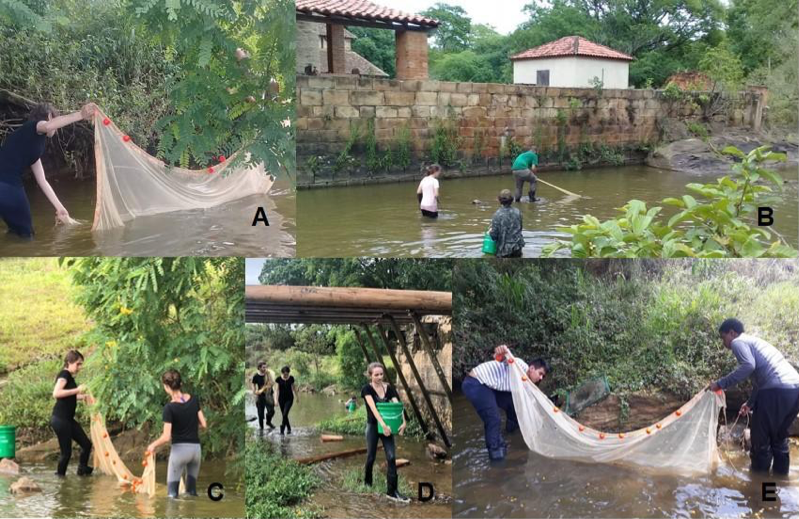A seca de 2019: operações de resgate e realocação de peixes conduzidas na Floresta Nacional de Ipanema, Iperó, São Paulo, Brasil
DOI:
https://doi.org/10.37002/biodiversidadebrasileira.v14i4.2508Palavras-chave:
Estiagem , ictiofauna , barramento , eventos extremosResumo
Os efeitos dos períodos de estiagem sobre a ictiofauna estão longe de serem compreendidos, já que se trata de um fenômeno que varia em extensão, intensidade e período de duração. O ponto de partida para esses estudos são, geralmente, as reduções drásticas nos níveis de precipitação, mas a análise isolada dos índices pluviométricos pode representar dados incompletos da real intensidade da estiagem, associada à influência das intervenções nos cursos de água como os barramentos. Portanto, o presente trabalho documenta o resgate de peixes a jusante de um barramento em um rio neotropical, localizado na Floresta Nacional de Ipanema, durante o período de estiagem ocorrido no ano de 2019 e suas consequências para as espécies de peixes. A seca desse período em particular, atingiu o seu máximo de intensidade entre agosto e setembro do ano em questão e o resgate ocorreu em novembro. O estudo utilizou também os dados pluviométricos de 2009 até 2019, a fim de obter maiores parâmetros comparativos. Foram resgatados 228 indivíduos de dezessete espécies, das quais dezesseis são nativas, uma é não-nativa e quatro são migradoras. Conclui-se que há necessidade de mais estudos para maior compreensão dos efeitos indiretos e subletais da estiagem e das altas temperaturas da água sobre os peixes, além de aprimorar os resgates e o manejo dos indivíduos quando expostos a tais condições extremas, uma vez que eventos extremos têm se tornado cada vez mais comuns.
Downloads
Referências
[1] Costa TRN, Carnaval ACOQ, Toledo LF. Mudanças climáticas e seus impactos sobre os anfíbios brasileiros. Revista da Biologia. 2018;8:33-7. DOI: https://doi.org/10.7594/revbio.08.06
[2] World Meteorological Organization. Greenhouse Gas concentrations hit record high. Again. Available from: https://wmo.int/news/media-centre/greenhouse-gas-concentrations-hit-record-high-again
[3] Nobre CA, Marengo JA, Seluchi ME, Cuartas L, Alves LM. Some Characteristics and Impacts of the Drought and Water Crisis in Southeastern Brazil during 2014 and 2015. Journal of Water Resource and Protection. 2016;8:252-62. DOI: https://doi.org/10.4236/jwarp.2016.82022
[4] Coelho CAS, Cardoso DHF, Firpo MAF. Precipitation diagnostics of an exceptionally dry event in São Paulo, Brazil. Theoretical and applied climatology. 2016;125(4):769-84. DOI: https://doi.org/10.1007/s00704-015-1540-9
[5] Coelho CAS, Oliveira CP, Ambrizzi T, Reboita MS, Carpenedo CB, Campos JLPS, et al. The 2014 southeast Brazil austral summer drought: regional scale mechanisms and teleconnections. Climate Dynamics. 2016; 46(11):3737-52. DOI: https://doi.org/10.1007/s00382-015-2800-1
[6] Taffarello D, Mohor GS, Calijuri MC, Mendiondo EM. Field investigations of the 2013–14 drought through quali-quantitative freshwater monitoring at the headwaters of the Cantareira System, Brazil. Water International. 2016;41(5):776-800. DOI: https://doi.org/10.1080/02508060.2016.1188352
[7] Cavalcanti IFA, Marengo JA, Alves LM, Costa DF. On the opposite relation between extreme precipitation over west Amazon and southeastern Brazil: observations and model simulations. International Journal of Climatology. 2017;37(9):3606-18. DOI: https://doi.org/10.1002/joc.4942
[8] Soler CMT, Sentelhas PC, Hoogenboom G. The impact of El Niño Southern Oscillation phases on off‐season maize yield for a subtropical region of Brazil. International Journal of Climatology: A Journal of the Royal Meteorological Society. 2010;30(7):1056-66. DOI: https://doi.org/10.1002/joc.1951
[9] Araújo RG, Andreoli RV, Candido LA, Kayano MT, Souza RAFD. A influência do evento El Niño-Oscilação Sul e Atlântico Equatorial na precipitação sobre as regiões norte e nordeste da América do Sul. Acta Amazonica. 2013;43:469-80. DOI: https://doi.org/10.1590/S0044-59672013000400009
[10] Oliveira LL, Costa Barreto NDJ, Santos Jesus E, Castro Canani LG. Efeitos dos eventos extremos climáticos na variabilidade hidrológica em um rio do Ecossistema Tropical Amazônico. Revista Ibero-Americana de Ciências Ambientais. 2020;11(4):145-53. DOI: https://doi.org/10.6008/CBPC2179-6858.2020.004.0013
[11] Grayson M. Agriculture and drought. Nature, London. 2013;501(7468):S1. doi: 10.1038/501S1a. DOI: https://doi.org/10.1038/501S1a
[12] Terassi PMB, Oliveira-Júnior JF, Góis G, Galvani E. Variabilidade do Índice de Precipitação Padronizada na Região Norte do Estado do Paraná Associada aos Eventos de El Niño-Oscilação Sul. Revista Brasileira de Meteorologia, São José dos Campos. 2018;33(1)11-25. DOI: https://doi.org/10.1590/0102-7786331002
[13] Gelcer E, Fraisse CW, Zotarelli L, Stevens FR, Perondi D, Barreto DD, et al. Influence of El Niño-Southern oscillation (ENSO) on agroclimatic zoning for tomato in Mozambique. Agricultural and forest meteorology, Amsterdam. 2018;248(1):316-28. DOI: https://doi.org/10.1016/j.agrformet.2017.10.002
[14] Douglas PMJ, Pagani M, Canuto MA, Brenner M, Hodelli DA, Eglinton TI, et al. Drought, agricultural adaptation, and sociopolitical collapse in the Maya Lowlands. The National Academy of Sciences, Washington, DC. 2015;112(18):5607-12. DOI: https://doi.org/10.1073/pnas.1419133112
[15] Lintermans M. Recovering threatened freshwater fish in Australia. Institute for Applied Ecology, University of Canberra, Canberra, ACT 2601, Australia. Marine and Freshwater Research. 2013;64(9):iii-vi. DOI: http://dx.doi.org/10.1071/MFv64n9_IN DOI: https://doi.org/10.1071/MFv64n9_IN
[16] Santana KNC, Torres CJF, Fontes AS, Costa AR, Peso-Aguiar MC, Santos ACA, et al. Efeitos da regularização dos reservatórios na Ictiofauna do baixo curso do rio São Francisco. Revista GESTA. [Internet]. 2016, december 14 [cited 2024, July 4];4(1):95-108. Available from: https://periodicos.ufba.br/index.php/gesta/article/view/15080 DOI: https://doi.org/10.9771/gesta.v4i1.15080
[17] Smith WS, Halcsik L, Biagioni RC, Pinheiro LAS, Stefani MS. An updated list of the ichthyofauna of Ipanema National Forest, São Paulo, Brazil. Check List. 2021;17(3):827–40 https://doi.org/10.15560/17.3.827. DOI: https://doi.org/10.15560/17.3.827
[18] Tonella LH, Ruaro R, Daga VS, Garcia DAZ, Vitorino OB Júnior, Lobato-de Magalhães T, et al. Neotropical Freshwater Fishes: A dataset of occurrence and abundance of freshwater fishes in the Neotropics. Ecology. 2023;104(4):e3713. doi: 10.1002/ecy.3713 DOI: https://doi.org/10.1002/ecy.3713
[19] Costa FCP, Monção MS, Nagamatsu BA, Pavanelli CS, Carvalho FR, Lima FCT, et al. Fishes of the upper Paraná river basin: diversity, biogeography and conservation. Neotrop. Ichthyol. 2024;22(1): e230066. https://doi.org/10.1590/1982-0224-2023-0066 DOI: https://doi.org/10.1590/1982-0224-2023-0066
[20] Oyakawa OT, Menezes NA. Checklist of fresh water fishes from São Paulo State, Brazil. Biota Neotrop. 2011;11:19–32. Available from: https://doi.org/10.1590/S1676-06032011000500002 DOI: https://doi.org/10.1590/S1676-06032011000500002
[21] Albuquerque GB, Rodrigues RR. A vegetação do Morro de Araçoiaba, Floresta Nacional de Ipanema, Iperó, SP. Scientia Florestalis. 2023;33(1):e64127. Available from: https://doi.org/10.5902/1980509864127 DOI: https://doi.org/10.5902/1980509864127
[22] Fávero OA, Nucci JC, Biasi MD. Mapeamento da vegetação e usos das terras da floresta nacional de Ipanema, Iperó/SP. GEOUSP Espaço e Tempo (Online), São Paulo, Brasil. 2003;7(1)47–57. DOI: 10.11606/issn.2179-0892.geousp.2003.123793 DOI: https://doi.org/10.11606/issn.2179-0892.geousp.2003.123793
[23] INMET. Instituto Nacional de Meteorologia. Dados Históricos anuais. Ministério da Agricultura, Pecuária e Abastecimento. [Internet]. 2019 [Accessed 2023, august 17]. Available from: https://portal.inmet.gov.br/dadoshistoricos.
[24] ICMBio. Sistema de Avaliação do Risco de Extinção da Biodiversidade – SALVE. 2023. [Accessed 2024, march 22] Available from: https://salve.icmbio.gov. br/
[25] Andreotti GF, Alves JC, Alves DC, Agostinho AA, Gomes LC. The response of fish functional diversity to the El Niño Southern Oscillation (ENSO) in a Neotropical floodplain. Hydrobiologia. 2021;848:1207-18. https://doi.org/10.1007/s10750-020-04491-9 DOI: https://doi.org/10.1007/s10750-020-04491-9
[26] Alves JC, Andreotti GF, Agostinho AA, Gomes LC. Effects of the El Niño Southern Oscillation (ENSO) on fish assemblages in a Neotropical floodplain. Hydrobiologia. 2021;848:1811-23. https://doi.org/10.1007/s10750-021-04555-4 DOI: https://doi.org/10.1007/s10750-021-04555-4
[27] Agostinho AA, Alves DC, Gomes LC, Dias RM, Petrete MJ, Pelicice FM. Fish die-off in river and reservoir: A review on anoxia and gas supersaturation. Neotropical Ichthyology. 2021; 19(3):e210037. https://doi.org/10.1590/1982-0224-2021-0037 DOI: https://doi.org/10.1590/1982-0224-2021-0037
[28] Everard M. The importance of periodic droughts for maintaining diversity in the freshwater environment. Aqua Docs. Journal Freshwater Forum. 2021;7:33-50.
[29] Silva MLH, Júnior ART, Castro ACL, Azevedo JWJ, Ferreira CFC, Cardoso RL, et al. Fish assemblage structure in a port region on the Amazonic coast. Iheringia, Série Zoologia. 2018;108:e2018018. doi: 10.1590/1678-4766e2018018 DOI: https://doi.org/10.1590/1678-4766e2018018
[30] Andrade BS, Singh CL, Santos JA, Gonçalves VVC, Siqueira-Souza FK, Freitas CEC. Efeitos das mudanças climáticas sobre as comunidades de peixes da Bacia Amazônica. Revista Ciências da Sociedade. 2018;2(4):107-123. http://dx.doi.org/10.30810/rcs.v2i4.905 DOI: https://doi.org/10.30810/rcs.v2i4.905
[31] Portella AC, Arsentales AD, Cavallari de, Smith WS. Efeito da sazonalidade na reprodução de peixes Characiformes em um rio Neotropical. Iheringia, Série Zoologia. 2021;111:e2021012. doi: 10.1590/1678-4766e2021012 DOI: https://doi.org/10.1590/1678-4766e2021012
[32] Lima FCT, Buckup PA, Menezes NA, Lucena CAS, Lucena ZMS, Toledo-Piza M, et al. Família Characidae: Gêneros incertae sedis. p.44-62. In: Buckup PA, Menezes NA, Ghazzi MS (eds.). Catálogo das espécies de peixes de água doce do Brasil. Rio de Janeiro, Museu Nacional. 2007:195.
[33] Lima JCS, Biagioni RC, Cunha CP, Cerqueira VLA, Vaz AA, Vaz AA, et al. Composição da Ictiofauna do Córrego Bebedouro (Frutal, MG) e sua relação com fatores ambientais. Acta Ambiental Catarinense. 2021;18(1). doi: 10.24021/raac.v18i1.5319 DOI: https://doi.org/10.24021/raac.v18i1.5319
[34] Graça WJ, Pavanelli CS. Peixes da planície de inundação do alto rio Paraná e áreas adjacentes. Maringá, Eduem. 2007;241p.
[35] Archdeacon TP, Diver TA, Reale JK. Fish Rescue during Streamflow Intermittency May Not Be E_ective for Conservation of Rio Grande Silvery Minnow. Water. 2020;12:3371. doi:10.3390/w12123371 DOI: https://doi.org/10.3390/w12123371
[36] Smith WS, Portella AC, Arsentales AD, Biagioni RC. Conectando peixes, rios e pessoas: como o homem se relaciona com os rios e com a migração de peixes. Organizador: Welber Senteio Smith. - Sorocaba, SP: Prefeitura Municipal de Sorocaba, Secretaria do Meio Ambiente. 2014;112:2014.
[37] Godinho AL, Lamas IR, Godinho HP. Reproductive ecology of Brazilian freshwater fishes. Environ Biol Fish. 2010;87(2):143-62. https://doi.org/10.1007/s10641-009-9574-4 DOI: https://doi.org/10.1007/s10641-009-9574-4

Publicado
Edição
Seção
Licença
Copyright (c) 2024 Os autores mantêm os direitos autorais de seus artigos sem restrições, concedendo ao editor direitos de publicação não exclusivos.

Este trabalho está licenciado sob uma licença Creative Commons Attribution-NonCommercial-NoDerivatives 4.0 International License.
Os artigos estão licenciados sob uma licença Creative Commons Atribuição-NãoComercial-SemDerivações 4.0 Internacional (CC BY-NC-ND 4.0). O acesso é livre e gratuito para download e leitura, ou seja, é permitido copiar e redistribuir o material em qualquer mídia ou formato.











